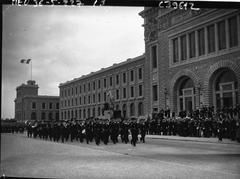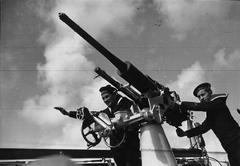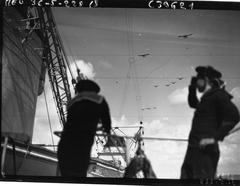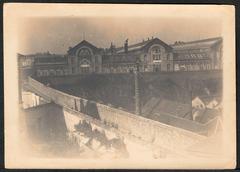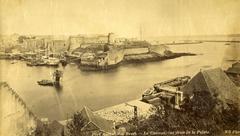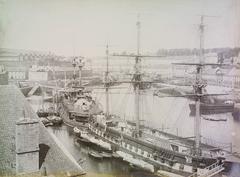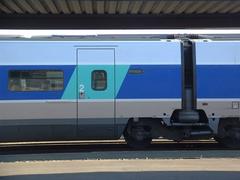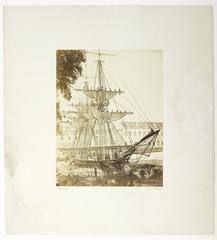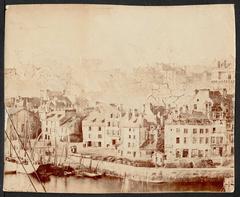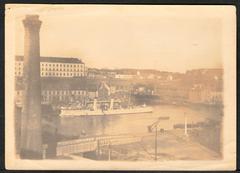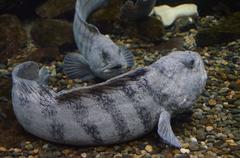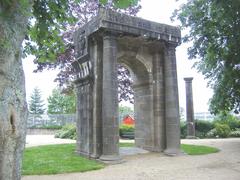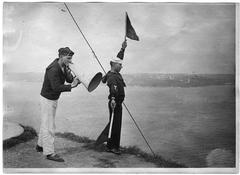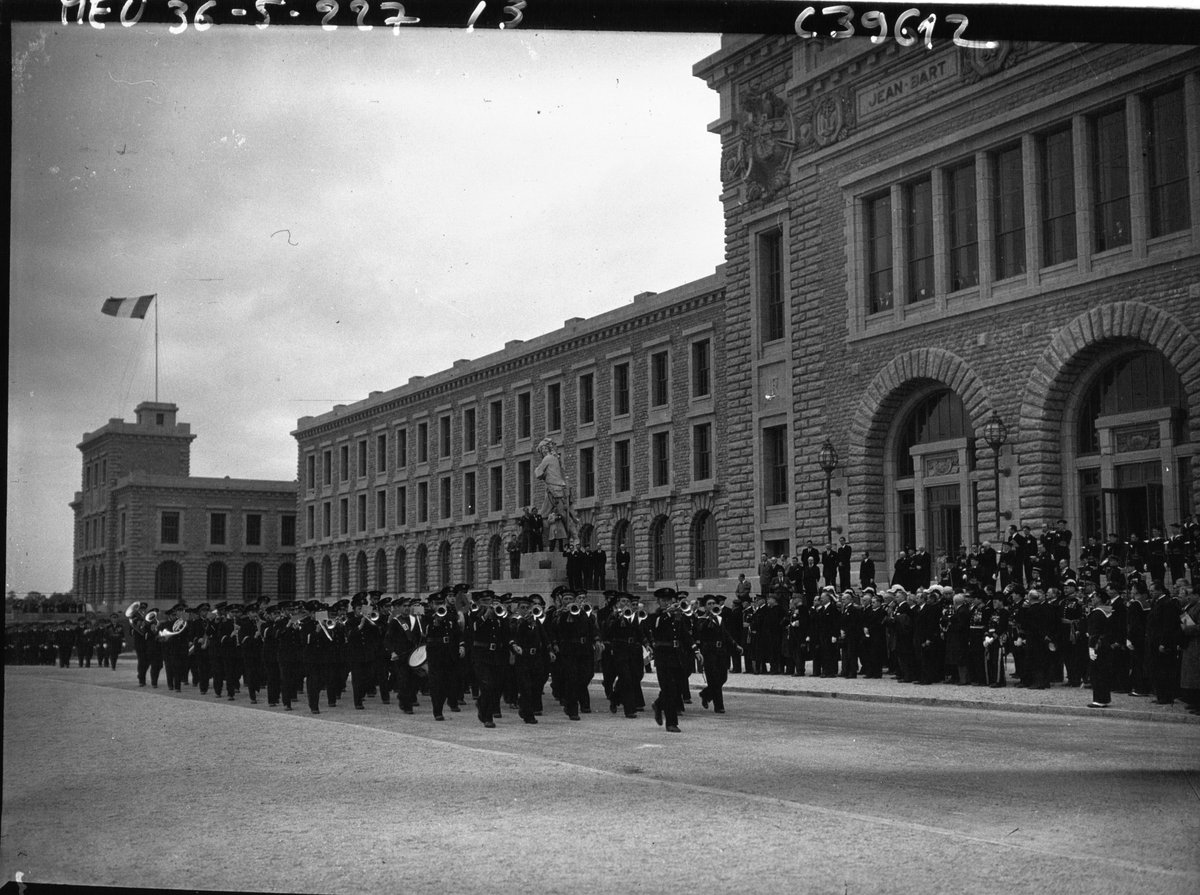
Visiting École de Maistrance Brest, France: Comprehensive Guide to Hours, Tickets, and Nearby Historical Sites
Date: 14/06/2025
Introduction
Located within the strategic naval hub of Brest, France, the École de Maistrance stands as a vital institution for the French Navy, training the next generation of non-commissioned officers (NCOs). With roots tracing back to the 19th century and a modern incarnation established in 1988, the school is both a symbol of France’s maritime heritage and a center of cutting-edge military education. While École de Maistrance is primarily a secure military facility, it occasionally opens its doors to the public, offering rare insights into French naval traditions and training.
This guide offers a detailed look at the school’s history, its educational role, practical information for visitors, and recommendations for exploring Brest’s rich naval history. Whether you are a military enthusiast, a history buff, or a traveler seeking to experience Brittany’s maritime legacy, this article provides everything you need to plan your visit to École de Maistrance and nearby attractions (École de Maistrance Wikipedia, Marine Nationale, Brest Naval Training Centre).
Table of Contents
- Introduction
- Historical Background and Evolution
- Structure of Training Programs
- Campus Facilities and Visitor Experience
- Visiting École de Maistrance: Hours, Tickets, and Tips
- Nearby Attractions in Brest
- Traditions, Honors, and Ceremonies
- Role in National Defense and International Cooperation
- Frequently Asked Questions (FAQ)
- Summary & Recommendations
- References
Historical Background and Evolution
Foundations and Early Development
The concept of “maistrance” emerged in 1859 to signify formal training for ship maintainers in the French Navy. In 1923, the school began structured instruction for future NCOs and was officially named École de Maistrance in 1933. The curriculum expanded over time to include technical and operational specialties vital for evolving naval needs (École de Maistrance Wikipedia).
Wartime and Post-War Changes
World War II forced the school to relocate several times, from Brest to Bordeaux, Morocco, and Toulon, ensuring the continuity of training during conflict. After the war, the institution modernized its curriculum to accommodate emerging technologies and to support the modernization of the French Navy.
Modern Era and Institutional Integration
With the closure of the École des Mousses in 1988, its traditions were transferred to École de Maistrance, which itself became part of the Centre d’instruction naval de Brest (CIN). The school is overseen by the Direction du personnel militaire de la marine and continues to evolve, now admitting around 400 students per year, typically aged 18–25 (Brest Naval Training Centre).
Structure of Training Programs
Duration and Phases
The core training program at École de Maistrance spans approximately 18 weeks of foundational military and naval education, followed by specialized training and additional management modules. Certain tracks, such as medical specializations, may last up to 3.5 years (Marine Nationale Formation).
Training Phases
- Military and Naval Induction (6 weeks): Focus on discipline, tradition, fitness, and seamanship.
- Academic and Technical Training (6 weeks): Core naval knowledge, technical fundamentals, and operational skills.
- Specialization (6+ weeks): In-depth instruction tailored to the student’s chosen field.
Graduates are promoted to the rank of second maître (petty officer second class) and continue with advanced operational training (Aumilitaire Forum).
Specializations
The school offers diverse technical and operational paths, including:
- Maritime Techniques: Navigation, ship handling, and command tracks.
- Networks & Telecommunications: Information systems and communications.
- Electronics & Electrotechnics: Radar, sonar, and electronic warfare.
- Mechanics: Marine propulsion and auxiliary systems.
- Aeronautical Trades: Aircraft maintenance and flight operations.
- Defense & Security: Shipboard security, firefighting, anti-terrorism.
- Medical Services: Naval medics and nurses.
- Administration: Logistics, HR, finance.
- Culinary Trades: Onboard food services.
Only some specializations, notably maritime techniques, provide direct pathways to eventual command positions (Aumilitaire Forum).
Campus Facilities and Visitor Experience
Campus Layout and Accessibility
École de Maistrance is situated within the secure Brest Naval Base, offering a professional yet welcoming environment. The campus incorporates classrooms, dormitories, technical workshops, and recreational spaces, set against the scenic backdrop of the Rade de Brest (Marine Nationale Formation).
Training and Educational Facilities
- Modern Classrooms: Equipped for interactive and technical learning.
- Simulation Rooms: For navigation, crisis management, and technical exercises.
- Workshops: Hands-on mechanics, electronics, and IT labs.
- Maritime Training Pools: Used for survival and safety drills.
- Drill Grounds and Sports Facilities: For physical and ceremonial training.
Accommodation and Daily Life
- Dormitories: Organized by cohort, fostering camaraderie.
- Mess Hall: Offers nutritious meals, supporting the demanding training schedule.
- Uniforms & Equipment: Issued upon arrival, symbolizing naval commitment.
Medical and Welfare Services
An on-site medical center and welfare staff provide support for student well-being.
Visiting École de Maistrance: Hours, Tickets, and Tips
Visiting Hours and Access
As an operational military establishment, École de Maistrance is not open for casual public visits. Access is only permitted during special events, such as:
- Open Day (“Journée Portes Ouvertes”): Usually held annually in February.
- European Heritage Days (September): Occasional public access.
- Major National Celebrations: Such as Bastille Day or Navy Week.
Advance registration is essential, and capacity is limited (Marine Nationale Events).
Tickets and Registration
- No admission fee for open events, but advance registration is required.
- Register through the official Marine Nationale events portal or Brest Tourism.
- Bring valid government-issued ID on the day of your visit.
Security Protocols
- Security screening at entry.
- Photography is restricted except in designated areas; always request permission.
- Dress modestly and respect military decorum.
Accessibility
Facilities are accessible to visitors with reduced mobility, but advance notice is advised to arrange suitable access.
Language Support
Most tours and signage are in French; limited English support may be available during open days.
Visitor Tips
- Register early to secure your place.
- Wear comfortable shoes and bring weather-appropriate clothing.
- Plan to explore nearby attractions for a well-rounded experience.
Nearby Attractions in Brest
Enhance your visit with these top sites:
- Château de Brest & National Maritime Museum: Medieval fortress housing naval exhibits and offering panoramic port views.
- Tour Tanguy: Museum and observation point for Brest’s history.
- Les Ateliers des Capucins: Former naval workshop turned cultural hub.
- Océanopolis: Renowned ocean discovery center.
- Arsenal de Brest: The historic heart of Brest’s naval operations (access varies).
- Jardin du Conservatoire Botanique: Botanical gardens with rare plant collections.
- La Recouvrance Tall Ship Cruises: Experience Brest from the water on a period vessel.
- Pointe Saint-Mathieu: Scenic coastal spot with lighthouse and abbey ruins.
For more, see the Brest Tourism website.
Traditions, Honors, and Ceremonies
École de Maistrance is steeped in naval tradition, carrying the banner of the École des Mousses decorated with honors like the Légion d’honneur and Croix de guerre. Students participate in national ceremonies, including the Bastille Day parade, and uphold rituals that reinforce the values of honor, discipline, and esprit de corps (Brest Naval Training Centre).
Role in National Defense and International Cooperation
Graduates of École de Maistrance serve throughout the French Navy, including on the aircraft carrier Charles de Gaulle, submarines, and specialized units. The school supports international cooperation through exchange programs and participation in NATO, EU, and bilateral maritime initiatives (Marine Nationale International).
Frequently Asked Questions (FAQ)
Q: Can I visit École de Maistrance at any time?
A: No, visits are only permitted during open days or special events with advance registration.
Q: Are there tickets for tours?
A: Open events are free but require prior registration due to security protocols.
Q: Is the site accessible for people with disabilities?
A: Yes, but arrangements should be made in advance.
Q: Is photography allowed?
A: Only in designated areas and with permission during tours.
Q: Are English-language tours available?
A: Limited; most tours are in French, so non-French speakers should check in advance.
Q: What identification is required?
A: A valid passport or national ID card is mandatory.
Summary & Recommendations
École de Maistrance is a living embodiment of France’s naval tradition and operational excellence. While visitor access is limited, open days and special events offer a unique opportunity to experience the institution’s heritage, advanced facilities, and the camaraderie of its students. To maximize your visit:
- Plan well in advance and register for open events.
- Combine your visit with Brest’s historic sites for a comprehensive maritime experience.
- Respect security protocols and institutional customs for a smooth, rewarding visit.
For up-to-date information and exclusive content, consider using the Audiala app and following official French Navy channels.
References
- École de Maistrance Wikipedia
- Marine Nationale Formation
- Brest Naval Training Centre Wikipedia
- Brest Tourisme
- Marine Nationale Events
- Aumilitaire Forum
- Brest Tourism Website
